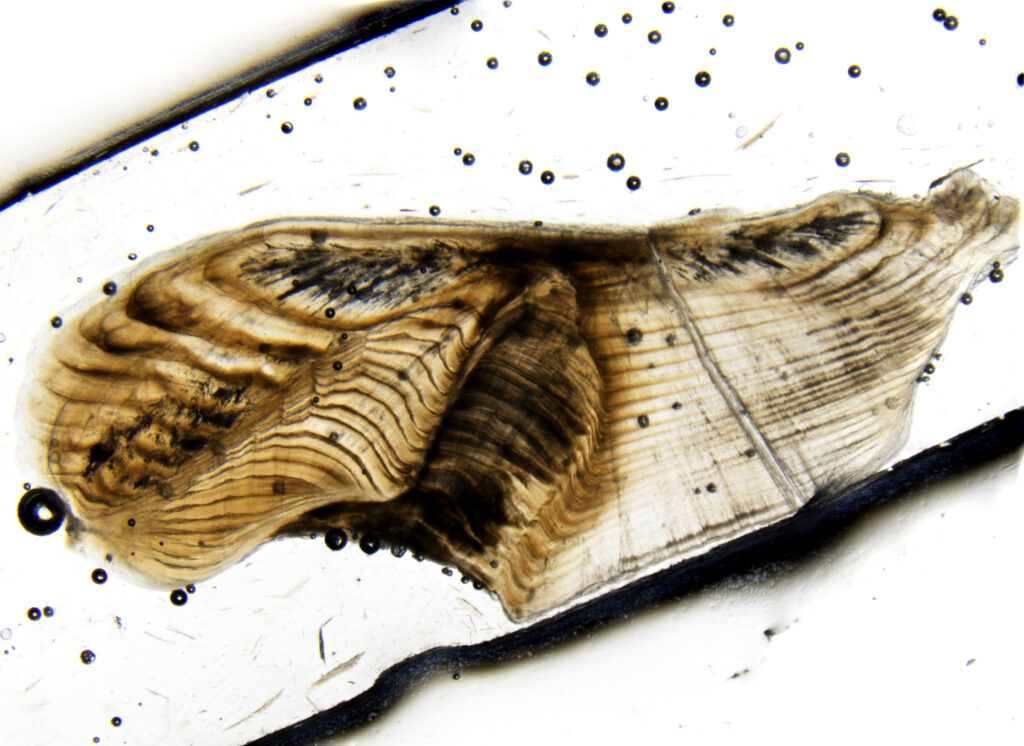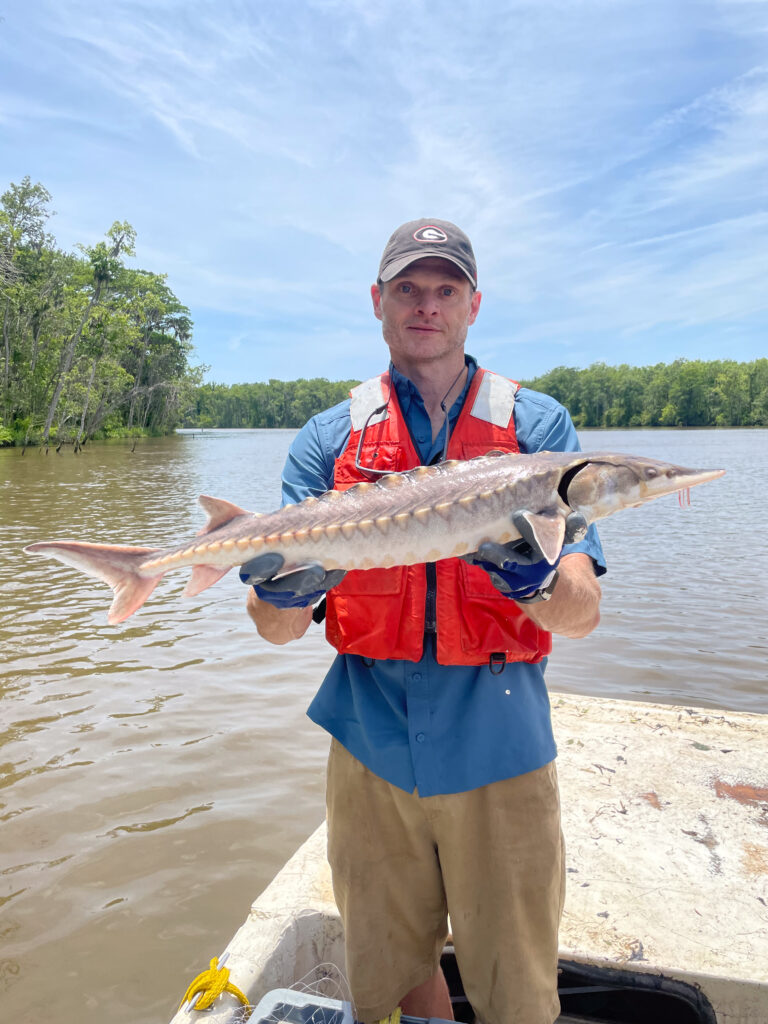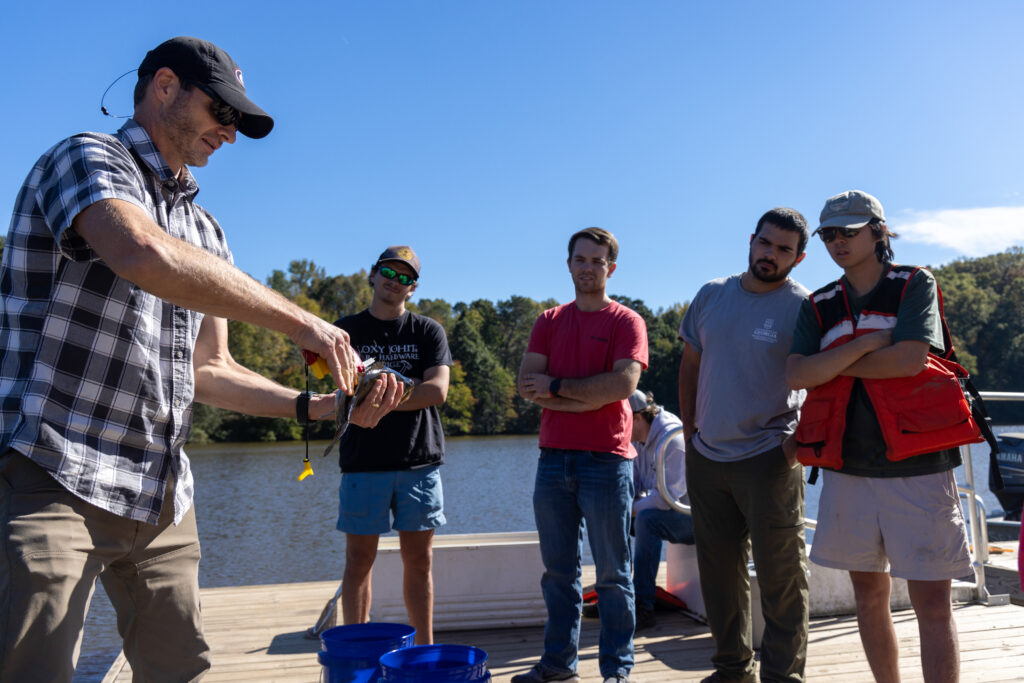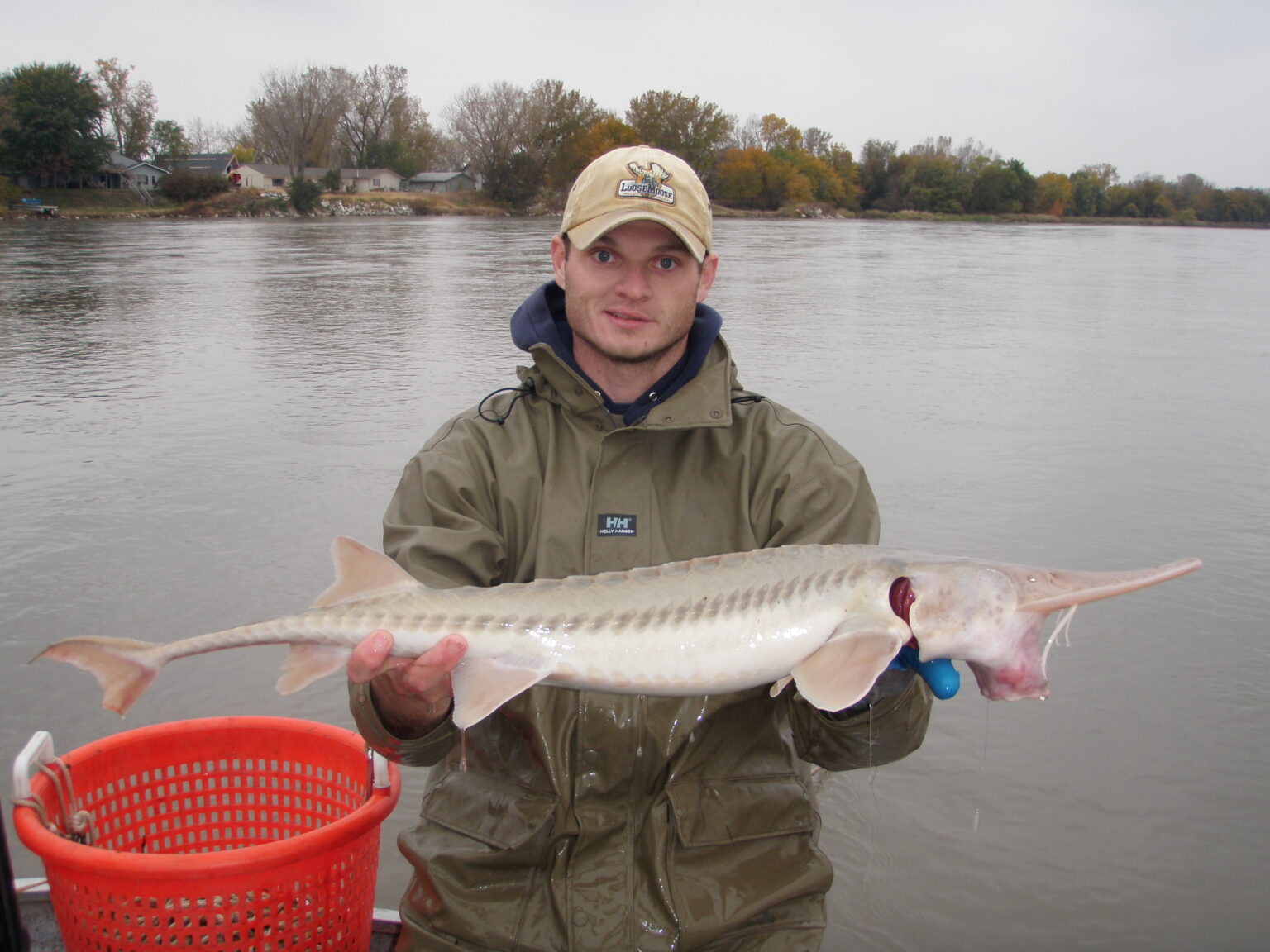For Marty Hamel, fishing isn’t just a hobby, or even a sport. It’s how he collects data for his research projects. The subjects of his research range from huge sturgeon to almost microscopic ear stones.
Hamel grew up in Iowa along the banks of the Mississippi River and has been fishing his whole life. His family took annual fishing trips to Minnesota in the summers, something he credits for sparking his fascination with fish and the environment. He didn’t know it then, but his love for fish would eventually lead him to become an associate professor of fisheries management and ecology in UGA’s Warnell School of Forestry and Resources, which he joined in 2019. He’s also an affiliate of the River Basin Center, a unit of the Odum School of Ecology that works to connect freshwater science to management and policy.
“I loved being outside. I loved interacting with the environment. But really, I had no clue that studying fish, or ecology for that matter, was a career option,” Hamel said.
Knowing he wanted to work with nature, Hamel enrolled in a program titled Conservation Management at Upper Iowa University. It wasn’t until he met an advisor who researched fish that he began to be aware of career opportunities in the field. He did his first research project on parasites in rock bass as an undergraduate student and went on to get a master’s degree in fisheries science at South Dakota State University.
After finishing his master’s, Hamel worked for a few years as a biologist for the Nebraska Game and Parks Commission, focusing on sturgeon in the Missouri River. While working there, Hamel got to know a faculty member at the University of Nebraska who was looking for a full-time research associate to manage a sturgeon research project on the Platte River. Hamel fit the bill.
As a full-time employee at Nebraska, tuition was waived, allowing him to earn a Ph.D. while also working for the university.
“It was taxing at times because I was juggling two different things, but it worked out really well,” he said. “It was a ton of field work, which was fun, especially for a young person that just wants to play with fish and be out in the water.”
Reading rings

An otolith is a tiny calcium carbonate structure found in the inner ear of a fish that facilitates hearing and balance. For scientists, however, these ear stones serve a very different purpose. The unassuming otolith contains a plethora of information about a fish’s life.
Under a microscope, one can see that otoliths have rings, like those of a tree. The otolith grows each year in proportion to the fish’s growth, so by counting and measuring these rings, researchers can discover information about a fish’s age and how much it has grown over time.
The issue with studying otoliths, and other calcified structures like fin spines, is that they can be very difficult to interpret and may not always produce accurate results. Depending on factors like the environment a fish lives in and how quickly it grows, the rings on calcified structures may not be distinguishable.
To combat this problem, Hamel is working with a team to create a publicly available database containing photographs of calcified structures from fishes of known age. Researchers will be able to refer to the database, which will be hosted by UGA, for examples of calcified structures to help them age fish more accurately. Hamel says the database will also be an important educational tool, helping students learn how to age fish using calcified structures.
Calcified structures from known-age fishes, especially long-lived ones, are not easy to come by, however.
“I work a lot with sturgeon, and some of those sturgeon may live for 50 to 100 years. To actually have a fish that we know for sure is 100 years old, that could span the life of two biologists. So, it’s really challenging to get known-age fish because typically we have to mark them with some sort of unique identifying mark when they’re very young,” Hamel said.
Recently, researchers have uncovered a new way to read these calcified structures: by studying their chemical makeup.
“Trace amounts of metals will get incorporated into these calcified structures in proportion to what is found in the water, leaving a fingerprint of where the fish has been throughout its life, Hamel said. “It is a great tool for looking at movement and behavior of fish that make long-distance migrations.”
This tool can be used to understand reproductive information. For anadromous fish, or fish that live in the sea and migrate up freshwater rivers to spawn, otoliths can be used to identify how frequently and where they spawn. Water chemistry varies dramatically between marine and freshwater environments, and by identifying at what point a fish was in either setting, researchers can learn a lot about their life history.
This unique tool also allows Hamel to study the origins of invasive species like the weather loach, which was first identified in Georgia in 2020.
“We’ve used otolith microchemistry to look at questions like: Were these fish introduced from an outside source? Were they naturally produced in the system? When did the introduction event occur?”
Sturgeon studies

Sturgeon have been a mainstay in Hamel’s research over the years, and he’s worked with several species.
Catching sturgeon can be a challenging task. One option for catching these fish is with stationary nets that are put in place and retrieved later. The large, harsh rivers Hamel has worked in, however, carry a tremendous amount of sediment. By the time these nets are ready to be retrieved, they are covered in sediment, making it very difficult to lift them out of the river.
What Hamel found to be the best capture method in these systems are trotlines, which are fishing lines attached to baited hooks. He used nightcrawler worms as bait and left the lines out overnight, picking them up the next day. “I was truly fishing for a living for a while, but after baiting more than 70,000 hooks, I was definitely to the point where I didn’t want to see another nightcrawler again.”
One of Hamel’s sturgeon projects in the Missouri River explored phenotypic plasticity in pallid sturgeon. Phenotypic plasticity is the ability of an organism’s phenotype, or outward expression of genes, to shift in response to environmental stimuli.
The study began with an observation: pallid sturgeon in the upper reaches of the Missouri River are much larger than those in the lower stretches. Luckily for Hamel and his team, the Endangered Species Program unintentionally created an experiment that could shed light on the size discrepancy. They stocked pallid sturgeon throughout the river, but the brood stock, or parents, all came from the upper Missouri River.
As the fish matured, they began to show different physical characteristics despite having the same genetic origins. The lower Missouri River has undergone a lot more human change, and it has been highly channelized, creating a narrow, fast-flowing environment. The fish in this part of the river were smaller than those in the upper section and had shorter lives.
Hamel’s analysis showed the lower Missouri River pallid sturgeons’ longevity to be almost three times less than the others. These findings demonstrated that the environment pallid sturgeon lived in affected their size and longevity.
“It was unique in that we saw that this really long-lived fish was exhibiting these plastic responses,” Hamel said, “They could change without having a genetic adaptation.”
Reeling it in

For Hamel, education is an essential part of fisheries science. He prioritizes hands-on learning in his classes.
“The hands-on component is where you really spark the interest, where you get people to fall in love with the field,” he said.
He wants to build a deep desire in his students to learn about fish and aquatic ecosystems, and he believes getting out there and experiencing it, like he did during his childhood and higher education, is the best way to build that desire. He enjoys giving students the information and tools they need to create their own research projects. Some of his students have gone on to become his peers as biologists working for state and federal agencies.
For his own projects, Hamel enjoys variety. Though a lot of his research is done in riverine systems, he doesn’t shy away from addressing problems that may not be in riverine systems or even working with native fish. He has done projects on sportfish and invasive aquatic plants.
“I like asking questions, and helping people that are in need of addressing those questions,” he said.
Creativity and working across disciplines is important for the future of fisheries science and management, according to Hamel. He cites the Network for Engineering with Nature, which pairs ecologists with engineers to build more ecologically beneficial structures, as a good example of the benefits of working across disciplines to build a better future.
“Humans are ubiquitous across the landscape. That’s not going to change. Our towns and cities are built along rivers,” he said. “Being creative in how we can incorporate human-made structures that are more ecologically friendly, and training engineers in ecology and ecologists having more engineer training will definitely be valuable.”

